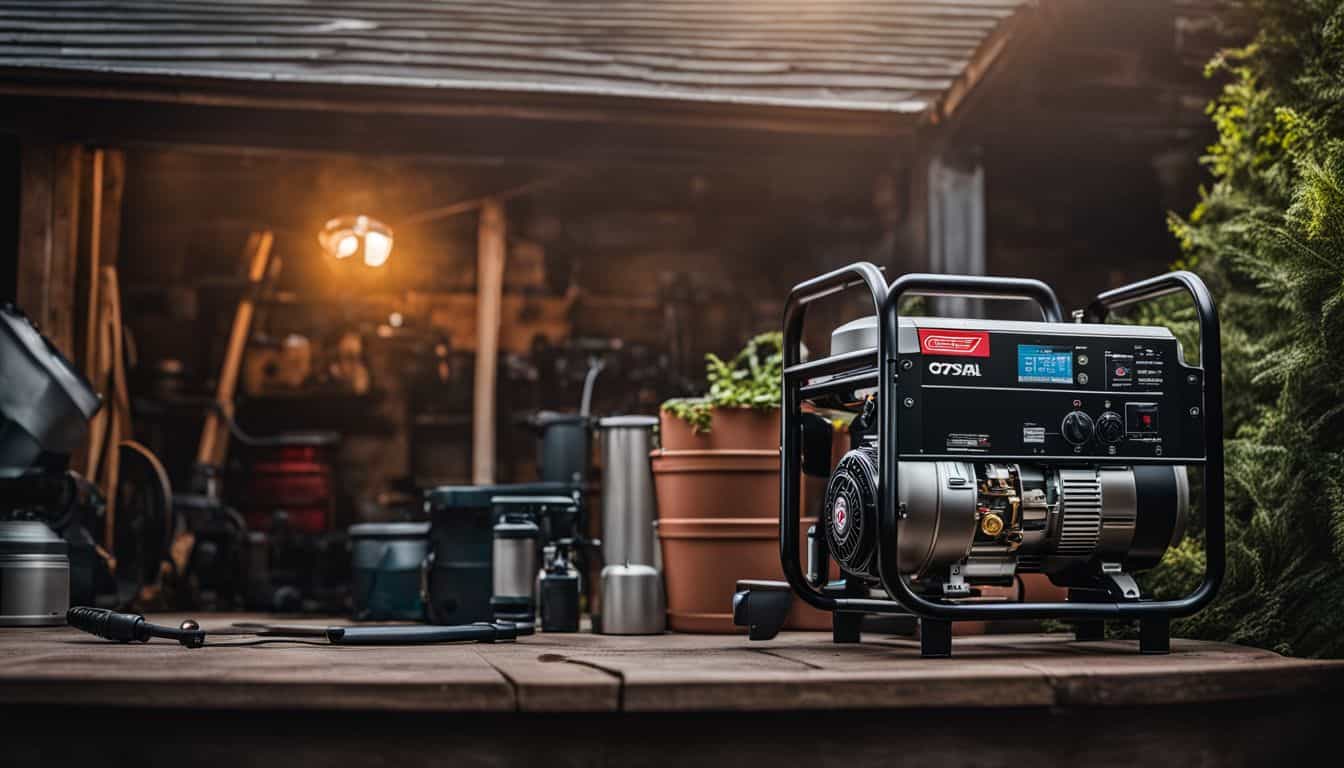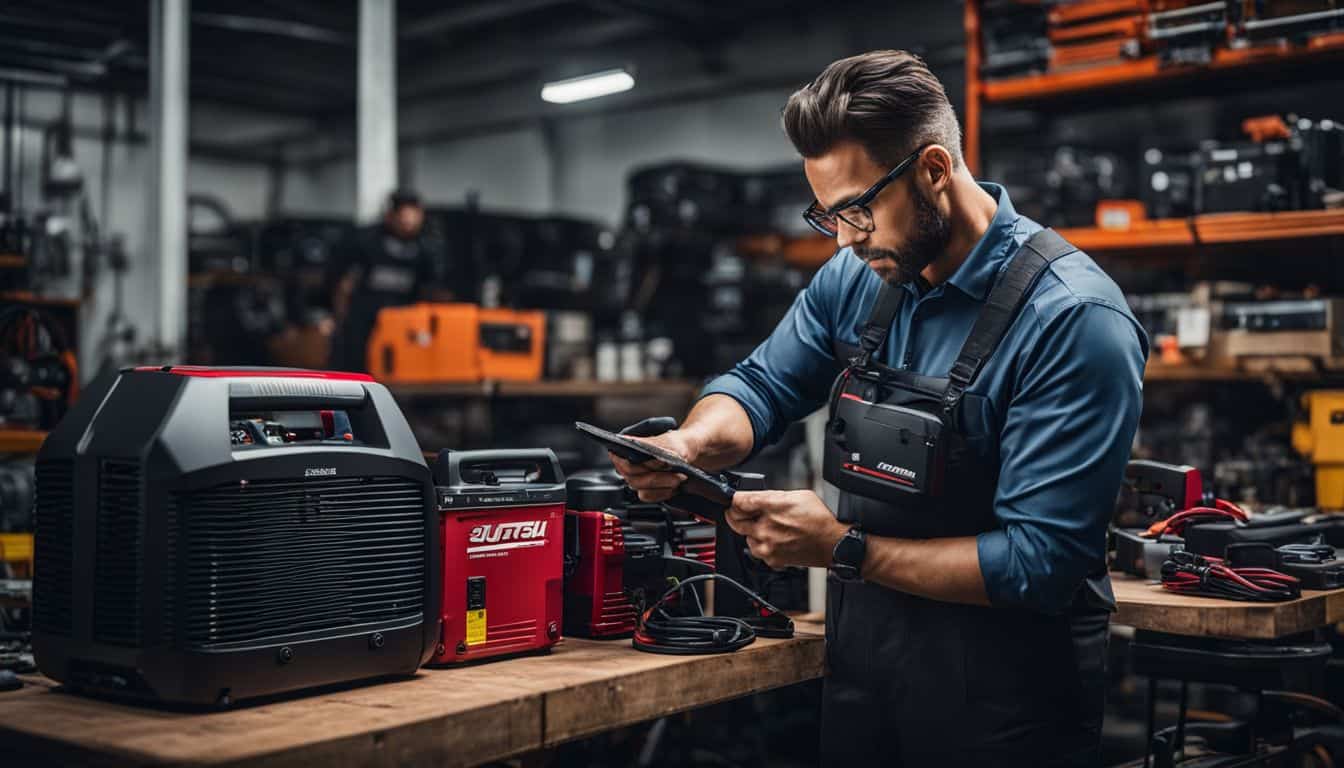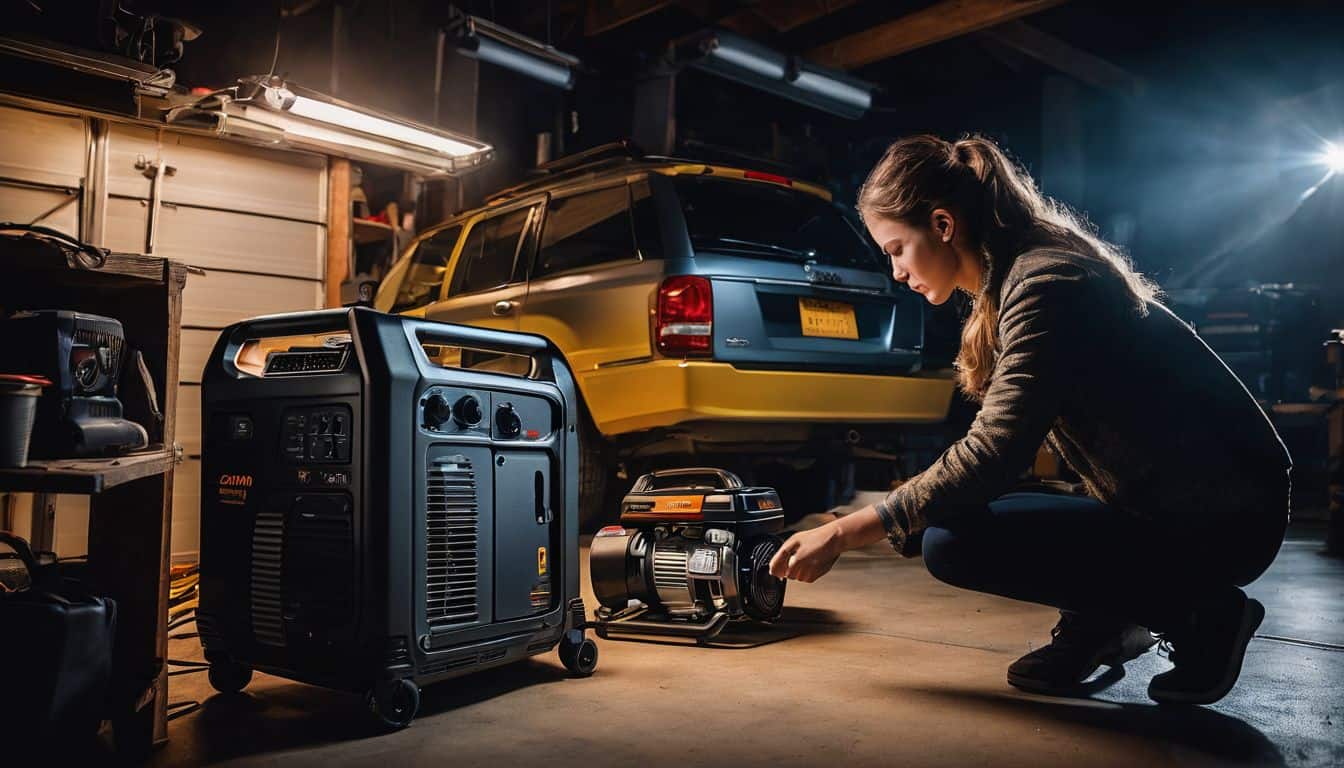Portable generators provide power in various situations, from outdoor events to emergency backup during outages. However, like any mechanical device, they can encounter issues. Understanding how to troubleshoot common problems can save you time, money, and frustration. This guide will walk you through the most frequent issues and their solutions.
Before diving into specific problems, it’s helpful to understand how portable generators work. This knowledge will provide context for the troubleshooting steps we’ll discuss.
Generator Components and Testing
One of the most critical aspects of generator troubleshooting is understanding and testing the core electrical components. Here’s what you need to know about testing your generator’s electrical system:
Testing the Alternator
The alternator is your generator’s powerhouse, consisting of the rotor and stator that work together to produce electricity. To test it properly:
Step-by-Step Testing Procedure
- Set your multimeter to AC voltage mode
- Connect the red lead to the generator’s output terminal
- Connect the black lead to the ground terminal
- Start the generator and let it warm up
- Check for a steady reading of 120V (±5%) at 60Hz
Residual Magnetism Issues
When your generator produces low or no power, loss of residual magnetism might be the culprit. Here’s how to address it:
Restoring Residual Magnetism
- Turn off and unplug all loads from the generator
- Connect a corded power drill to one of the generator outlets
- Start the generator and let it reach full operating speed
- Quickly squeeze and release the drill trigger 2-3 times
- Test the voltage output again with your multimeter
Component Testing Guide
Regular Testing Schedule
- Test voltage output weekly during regular use
- Check all outlets monthly for proper voltage
- Inspect brush condition every 100 operating hours
- Test automatic voltage regulator quarterly
Warning Signs to Watch For
- Fluctuating voltage readings
- Unusual humming from the alternator
- Intermittent power output
- Burning smell during operation
Remember that proper testing and maintenance of these components can prevent many common electrical issues and extend your generator’s lifespan.
Failure to Start
One of the most common issues generator owners face is a unit that won’t start. This problem can stem from several sources:
Fuel-related Problems
- Empty fuel tank or stale fuel: Always ensure your generator has fresh fuel. Stale fuel can clog the system and prevent starting.
- Closed fuel shutoff valve: Check that the fuel valve is open before attempting to start.
- Clogged fuel lines or carburetor: Fuel residue can build up and obstruct fuel flow over time. Regular maintenance can prevent this issue.
Battery Issues (for electric start models)
- Dead or weak battery: If your generator has an electric start, a dead battery will prevent it from starting. If available, try using the manual start or charging/replacing the battery.
- Corroded or loose battery connections: Clean and tighten battery terminals to ensure proper electrical contact.
Oil-related Problems
- Low oil level: Many generators have an automatic shutoff for low oil levels. Check and top up oil as needed.
- Oil sensor malfunction: The oil sensor might be faulty if the oil level is adequate, but the generator still won’t start.
Rough Operation or Stalling
If your generator starts but runs poorly or stalls, consider these potential causes:
- Fuel quality issues: Poor quality or old fuel can cause erratic operation. Drain the old fuel and refill with fresh gasoline.
- Clogged air filter: A dirty air filter restricts airflow, causing poor performance. Clean or replace the filter regularly.
- Spark plug problems: Fouled or damaged spark plugs can cause misfires. Check the spark plug condition and gap, replacing if necessary.
No Power Output
A generator that runs but produces no electricity could be because of:
- Tripped circuit breaker: Check and reset the main circuit breaker if necessary.
- Overloading: Ensure you’re not exceeding the generator’s capacity.
- Loss of residual magnetism: This rare issue may require professional attention to re-energize the generator’s magnetic field.
- Faulty voltage regulator: A malfunctioning regulator can prevent proper power output.

Diagnostic Flowchart for No Power Output
When your generator isn’t producing power, following a systematic diagnostic approach can help identify the issue quickly. Here’s a comprehensive troubleshooting guide:
Initial Checks
First Response Steps
- Verify the generator is running at full operating speed
- Check and reset all circuit breakers
- Ensure all power cords are properly connected
- Confirm the main circuit breaker isn’t tripped
Voltage Testing Procedure
Using Your Multimeter
- Set multimeter to AC voltage (120V/240V range)
- Test each outlet individually
- Normal readings should be:
- 120V outlets: 118-122V
- 240V outlets: 236-244V
- Frequency: 59-61Hz
No Voltage Present
If your multimeter shows zero voltage, check these components in order:
Engine Speed Verification
- Listen for consistent engine sound
- Check if engine maintains proper RPM under load
- Verify governor adjustment
- Test throttle response
Electrical System Checks
- Inspect brush condition and connections
- Test automatic voltage regulator (AVR)
- Check capacitor function
- Verify all internal wiring connections
Low Voltage Issues
When voltage is present but low, investigate these areas:
Load Management
- Disconnect all loads
- Test voltage with no load
- Add loads one at a time
- Monitor voltage changes
Component Testing
- Check capacitor performance
- Verify brush spring tension
- Test stator windings
- Inspect rotor condition
When to Call a Professional
Seek expert help if you encounter:
- Internal electrical component failure
- Damaged AVR
- Failed capacitor
- Complex wiring issues
- Burnt stator or rotor windings
Following this systematic approach helps identify the root cause of power output issues while maintaining safety and preventing further damage to your generator.
Low Power Output
If your generator is producing power but not at full capacity, consider:
- Generator not running at the correct speed: The engine must maintain the correct RPM to produce the rated power.
- Partial load on generator: Some generators perform best under a substantial load. If you’re only using a small portion of the generator’s capacity, try connecting more devices.
- Worn or damaged components: Internal wear can reduce power output over time.
Excessive Noise or Vibration
Unusual noise or vibration can indicate:
- Loose parts: Regularly check and tighten all accessible bolts and screws.
- Damaged muffler: A damaged muffler can significantly increase noise levels.
- Unbalanced load: Ensure the generator is on a level surface and the electrical load is balanced across available outlets.
Preventive Maintenance Schedule
Regular maintenance is crucial for keeping your generator reliable and extending its lifespan. Follow these maintenance intervals for optimal performance:
Weekly Maintenance Tasks
Basic Checks
- Check oil level before each use
- Inspect fuel level and quality
- Look for loose connections or damage
- Test generator operation under load
- Clean debris from exterior vents
Monthly Service Items
Essential Inspections
- Clean or replace air filter
- Check spark plug condition
- Inspect battery connections
- Test all outlets with multimeter
- Check fuel lines for cracks
- Verify automatic transfer switch operation
Annual Maintenance
Comprehensive Service
- Change engine oil and filter
- Replace spark plugs
- Clean or replace fuel filter
- Test voltage regulator function
- Inspect all wiring connections
- Clean fuel tank sediment
- Lubricate all moving parts
Maintenance Tips to Prevent Problems
Regular maintenance is critical to preventing many common issues:
- Perform regular oil changes as recommended by the manufacturer.
- Practice proper fuel management, including using fuel stabilizers for long-term storage.
- Clean or replace the air filter regularly, especially in dusty environments.
- Schedule professional inspections to catch potential issues early.
For an overview of how generators work, check out our guide on the basics of portable generators explained.
When to Seek Professional Help
While many issues can be resolved with basic troubleshooting, some problems require professional attention:
- Complex electrical issues that go beyond simple circuit breaker resets.
- Internal engine problems, especially if you’re not comfortable with engine mechanics.
- Any issues that might affect your warranty – always consult your warranty terms before attempting major repairs.

Professional Service Guidelines
While many generator issues can be resolved at home, certain problems require professional expertise:
Engine Issues
- Internal mechanical damage
- Severe oil leaks
- Damaged crankshaft
- Failed bearings
- Compression problems
Electrical Problems
- Automatic voltage regulator failure
- Damaged stator windings
- Rotor malfunction
- Complex wiring issues
- Transfer switch failures
Fuel System Maintenance
Proper fuel management prevents many common generator problems and ensures reliable operation.
Fuel Storage Guidelines
Best Practices
- Use fresh fuel within 30 days
- Maintain fuel tank at 85% capacity
- Add fuel stabilizer for storage
- Store fuel in approved containers
- Keep fuel clean and water-free
Carburetor Maintenance
Regular Care
- Clean carburetor annually
- Replace fuel filter every 100 hours
- Adjust idle mixture when needed
- Clear fuel lines regularly
- Check float bowl condition
Storage Preparation
- Drain fuel system completely
- Run engine until fuel is consumed
- Clean carburetor bowl
- Add fresh fuel with stabilizer
- Run engine for 10 minutes
Following these maintenance guidelines and knowing when to seek professional help will significantly improve your generator’s reliability and longevity.
Conclusion
Understanding how to troubleshoot common portable generator problems can save you time and money while ensuring you have power when needed. Regular maintenance and prompt attention to issues, as they arise, will keep your generator running smoothly for years. When in doubt, it’s always best to consult a professional to avoid potentially costly mistakes or safety hazards.
FAQS
What are some common reasons a portable generator won’t start?
There are several simple issues that can prevent a portable generator from starting:
– The fuel tank is empty or low on gas
– The battery is dead or weak
– Coolant levels are too low
– Fuel is leaking back into the tank instead of reaching the engine
What regular maintenance tasks help avoid problems with portable generators?
To keep a portable generator running smoothly and prevent issues, perform these maintenance tasks:
- Check the oil and fuel levels regularly
- Clean or replace the air and fuel filters as needed
- Ensure all electrical connections are tight and secure
- Inspect fuel lines for cracks or leaks and replace if damaged
If a generator is having trouble starting, what should I check first?
When troubleshooting a portable generator that won’t start easily, begin with the simplest potential causes:
- Verify that all switches are in the correct positions
- Check that circuit breakers haven’t been tripped
- Make sure the choke is set properly for a cold start
- Test the battery and replace or recharge it if weak
What could cause a portable generator to run rough or produce no power?
Some issues that can lead to a portable generator running poorly or failing to generate electricity:
- Old or contaminated fuel clogging the carburetor
- Loose or corroded wiring connections
- Loss of residual magnetism in the generator
- Low oil level causing the low oil shutoff to engage
How can I troubleshoot a portable generator that starts but produces no power?
If your generator runs but doesn’t provide power, try these steps:
- Confirm that the main circuit breaker is in the “on” position
- Check that any GFCI outlets haven’t been tripped
- Inspect the power cord and outlets for damage or loose connections
- Verify the generator’s brushes and slip rings are in good condition
What should I do if my generator keeps shutting off after starting?
A portable generator that starts briefly but then shuts down could indicate:
- The low oil sensor is activated due to insufficient oil
- The fuel valve is closed or clogged, restricting gas flow
- The air filter is dirty, preventing proper air intake
- The spark arrestor is clogged with soot, choking the engine
When should I take my portable generator to a professional for repairs?
While many generator issues can be resolved with simple troubleshooting, some problems are best left to the pros:
- The generator makes strange noises or emits smoke
- You see sparks or smell burning wires
- The generator won’t start after checking all common causes
- You are unsure how to safely diagnose or fix the problem
For complex repairs, always have your portable generator serviced by a qualified technician.

Leave a Reply